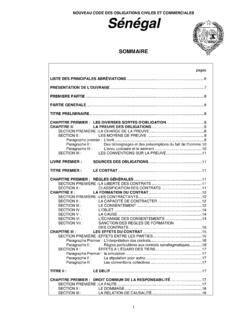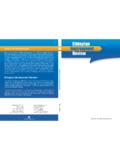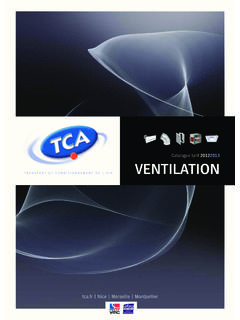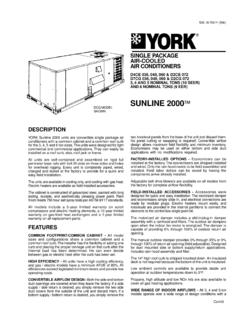Transcription of Use, format and content of standard debt collection ...
1 Use, format and content of standard debt collection communication Guidance document Produced in association with the Office of Fair Trading (OFT). Contents Guidance topic A. Executive summary 3. 1) Introduction 2) Service provider or purchaser? 3) Consumer v commercial debt B. Tracing 4. 1) Soft letters and postcards 2) Soft trace letters addressed to The Occupier . C. content general 6. 1) Settlement letters 2) Statements and phrases 3) Sensitive cases 4) Sending debt collection letters addressed to The Occupier . D. content legal 9. 1) Describing the legal process 2) Appropriate and Viable Legal Action 3) Timing of Issue of Letters Referring to Legal Action E. Design 12. 1) Look-a-like' letters and use of boxes 2) Logos 3) Letter font F. Trading names 14. 1) Misleading use of trading styles 2) Misleading terms/names 3) Inappropriate trading names G. Other methods of contact 17.
2 1) Email 2) Text message H. debt purchase and new instructions 19. 1) Notice of assignment purchased debt 2) Assignment/transfer of debt acting on instruction December 2013 Use, format and content of standard debt collection communication 2. A. Executive summary 1. Introduction This guidance has been produced by the Credit Services Association ( the Association ) in association with the Office of Fair Trading ( OFT ). It is expected that Consumer Credit Licence holders will abide by the spirit as well as the letter of the OFT debt collection Guidance ( the DCG ). This guidance was initially produced following concerns from the OFT that it had seen letters which, in its opinion, did not fully comply with the DCG. Following on-going liaison with the OFT subsequent to the 2011 update to the DCG, this guidance has now been revised to incorporate the changes and to provide additional clarification on communication within the industry.
3 It does not set out standard text or templates and is not intended to prevent Members from designing letters in their own company style providing they remain compliant with the DCG and other relevant regulatory guidance, legislation and the CSA. Code of Practice. It provides guidance by highlighting a number of areas which Members need to consider when drafting and reviewing their collection letters. The OFT has advised that its consideration of standard letters is always on a case by case basis, taking into account a number of factors including: the stage at which the letter is sent out; consumer complaints received about the letter, and; any previous enforcement action taken by the OFT on similar issues. 2. Service Provider or purchaser? Although the debt collection and purchase industry understands the difference between acting on a contingent basis for clients and purchasing debt , it is apparent that outside the industry this distinction is far from clear.
4 It is therefore important that collection letters identify the creditor and the capacity in which the Member is acting, ie either on behalf of the creditor or as purchaser and assignee of the debt . 3. Consumer v commercial debt The OFT's role under the Consumer Credit Act 1974 is primarily concerned with consumer protection and therefore the collection of commercial or non-regulated debt will largely fall outside of the DCG and other consumer regulation. However, non-regulated debt will often still involve contacting a customer, whilst commercial debt can often include small traders, partnerships and directors who may have given personal guarantees, the majority of whom need to be treated in the same way as regular customer. Therefore, this guidance also applies in these cases. December 2013 Use, format and content of standard debt collection communication 3. B. Tracing 1.
5 Soft letters and postcards The OFT's concerns regarding data and data accuracy across the credit industry led to the introduction of a section in the DCG focusing entirely on this subject. If poor data is used during the trace and collect process and/or poor quality data is provided by some creditors this can lead to the wrong individuals being contacted for payment of a debt . This acts as a catalyst for a number of complaints. A debt collection agency (DCA) should not send communication referring to debt or disclosing debt or financial details to an individual unless it is reasonably certain that they are the customer in question. Therefore, unless a DCA is reasonably certain it is sending the letter to the actual customer, it should use correspondence that does not refer to the debt . This standard of reasonableness is measured on what other Members and regulators would objectively consider to be certain on the balance of probabilities in the circumstances.
6 The Association and the OFT agree that a distinction can be made between debts referred to a DCA for trace and collect activity and those referred purely for collection activity. With the latter, the Association would regard it as unreasonable to carry out trace activity and verification on all standard collection instructions received from clients on the basis that the information may be inaccurate. The Association therefore regards it as reasonable for a DCA. to rely on the information provided by clients in these circumstances as being the correct details for the customer. The OFT has told the Association that it would expect further checks to be carried out in circumstances where there have been problems with data from a specific client in the past or where complaints have highlighted possible data quality issues, particularly if the collection letters mention legal action.
7 With regard to trace and collect instructions, it is essential that the DCA carries out reasonable tracing and verification checks prior to any collection letters being issued. Members should refer to the Trace section of the Code of Practice for further information on verification tools. The OFT has confirmed it is happy with the format and content of the Soft Letter Template produced by the Association, and it is suggested this or similar wording is used in circumstances where a soft letter is required to verify the address of the customer. A copy of this template letter can be found on the Association's website, within the Tracing Factsheet (which was produced in association with the Information Commissioner's Office (ICO)). The Association has provided guidance previously on the use of postcards being sent to named trace subjects to seek a response from them to verify their identity.
8 Because the Companies Act 2006 requires a business to state its registered name, address and number on all correspondence, its identity is therefore available for anyone who reads the postcard to see. Consequently, third parties would be able to identify the postcard as having been sent by a consumer credit business to the individual. This would likely be a breach of the Data Protection Act 1998 and the OFT have expressed that they would consider it an unfair practice. December 2013 Use, format and content of standard debt collection communication 4. References OFT debt collection Guidance e, p, q; a, b, j; CSA Code of Practice 1 u, x; section 6. CSA Soft Letter Template CSA Tracing Factsheet 2. Soft trace letters addressed to The Occupier'. 3. The OFT was made aware of cases in which soft trace letters were being sent addressed to The Occupier even though the name of the customer was known.
9 The reason behind this was the belief that it would encourage the person living at the address to open the letter, which they may have been less likely to do if they received a letter addressed to them. 4. This was given some consideration by the Association and by the OFT, and the following conclusions were reached: If the address is correct and the letter is addressed to The Occupier , then there would be the risk that another occupant would open the letter and become aware of the customer's circumstances. This could potentially find the company in breach of the OFT DCG. in respect of publicly embarrassing a customer. If the address is incorrect and the resident of that address opens the letter, it is unlikely to affect how they choose to deal with the matter they may still proceed to ignore or throw away the letter. 5. In light of the above, it is the view of the Association and the OFT that where the name of the customer is known, best practice would be to send all correspondence addressed to that named individual (unless a third party representative has been authorised to deal with the matter).
10 6. Sending letters addressed to The Occupier' is unlikely to result in a positive impact that would justify the potential breach of regulations and the risk of complaints. 7. If the name of the customer is not known, such as may be the case with utility debt , then the use of soft trace letters addressed to The Occupier would be acceptable. The likelihood of any other type of account (regulated and non-regulated) not having the customer name is very low. See also Sending debt collection Letters addressed to The Occupier on page 8. References OFT debt collection Guidance p, q; a, b, j; a CSA Code of Practice 1 u, x; Section 6. December 2013 Use, format and content of standard debt collection communication 5. C. content general 1. Settlement offers The OFT regards it as a potentially oppressive business practice if letters making settlement offers are issued to individuals when it is not reasonably certain that they are the customer in question or have previously notified the DCA that they are not the customer in question, as this could be construed as pressurising the individual to pay.







